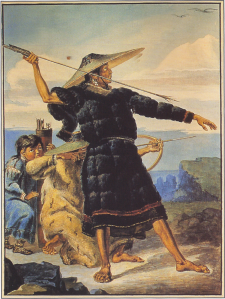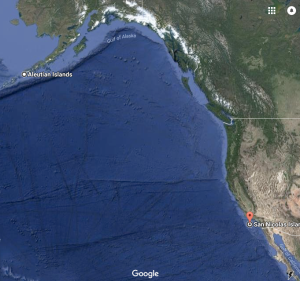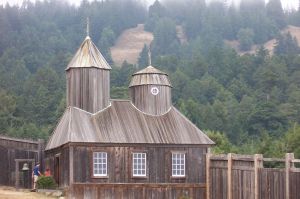
When we left off last week with Caughey’s History of the Pacific Coast, Vitus Bering and his men had heroically crossed Siberia twice, spent about 10 hours in Alaska, gotten stranded over winter in the Aleutian Islands, a bunch of them (including Bering himself) died of scurvy, and finally a few of them struggled back to Moscow. The result of all this human effort and travail was a rush to kill every last sea otter for their super soft and cuddly pelts.
As usual, I’m using “” instead of blockquotes for readability.
“Without waiting for authorization from the czar, traders scurried from Kamchatka to the Commander and Aleutian Islands. They sailed in most unseaworthy craft, small and crude, built usually of green timber, without iron, and consisting merely of a log frame covered with planks that were fastened with deer thongs and wooden peg and calked with moss and tallow for lack of pitch. … the willingness and eagerness of these adventurers to sail n such crazy craft over the stormy waters off Kamchatka testifies as to the profits in promise for successful voyages. …
“they went chiefly to the Aleutian Island, and did not visit the Alaskan mainland again until 1761. Shipwrecks occurred frequently, the estimate being one out of three… This was the period of unregulated hunting, characterized by the vilest outrages against the Aleuts, who suffered almost as much damage as the sea-otters.

“The Aleuts were depended upon for the actual hunting. The Russians hunted occasionally by long distance rifle shooting, but it was more convenient to utilize the natives. In calm weather they went out in kayaks and harpooned the sea-otters as they came up to breathe. Storm hunting on the kelp beds was more customary. In this wild work some of the Aleuts pursued the sea-otter in kayaks while others clubbed them as they came ashore. The danger was great, both in the fragile kayaks and on the slipper rocks. …
“the women of a village were seized as hostages and held until a satisfactory number of sea-otter pelts was brought in. This device lent itself to abuse and there were outrageous wrongs. The most spectacular concerned a ship which was blown back to Kamchatka with twenty-five hostages still on board. Rather than come into port with such incriminating evidence, the Russians unceremoniously dumped these women overboard to drown.”
Wikipedia has an interesting account of the far-reaching effects of this coercion:

There was high demand for the furs that the Aleut provided from hunting. In 1811, in order to obtain more of the commercially valuable otter pelts, a party of Aleut hunters traveled to the coastal island of San Nicolas, near the Alta California-Baja California border. The locally resident Nicoleño nation sought a payment from the Aleut hunters for the large number of otters being killed in the area. Disagreement arose, turning violent; in the ensuing battle, the Aleut killed nearly all the Nicoleño men. Together with high fatalities from European diseases, the Nicoleños suffered so much from the loss of their men that by 1853, only one living Nicoleña person remained. (See Juana Maria, The Lone Woman of San Nicolas, also known as Karana)
Back to Caughey: “By the middle 1760’s the Aleuts were aroused by these repeated atrocities to measures of retaliation. They met treachery with deceit and murder with assassination, and Russian blood flowed to atone for the slaughters of the Aleuts. This new sort of disturbance brought the region to the attention of the czar… A governor was sent out for the express purpose regulating this fur trade. … The Aleuts received but meager protection, and the czar’s revenues were not augmented to the extent anticipated. But during the period of government regulation there as an expansion of Russian fur hunting to Alaska proper. Kodiak was settled in 1783, and Shelikoff advanced to the Sitka neighborhood soon after.
“Toward the end of the century government regulation was abandoned in favor of control through a trading company modeled after those of the English. … Under the company conditions did improve. Missions were but slightly encouraged, but the natives received some safeguarding for the very practical reason that their perpetuation was vital to the continued profits of the fur trade.”

EvX: See my post on Kabloona, Religion and the Far Reaches of the World for more on Russian Orthodox missionaries to the Alaskan natives. Wikipedia notes:
After the arrival of Russian Orthodox missionaries in the late 18th century, many Aleuts became Christian. Of the numerous Russian Orthodox congregations in Alaska, most are majority Alaska Native in ethnicity. One of the earliest Christian martyrs in North America was Saint Peter the Aleut.
Continuing with Caughey, “Following an uprising of the natives, [Baranof] reestablished Sitka in 1803 and made it the capital of Russian America. Shipbuilding was one of his principal innovations; some fourteen vessels being launched in Alaska during his regime, 1799 to 1818. …
“Russian America’s insecurity was well revealed during the course of the inspection by Nikolai Rezanof in 1805-1806. … He found Sitka threatened with starvation because one of the supply ships from Siberia had not arrived. Scurvy had broken out, causing several deaths, and no prospect of securing supplies was apparent. He gave temporary respite by purchasing the American ship Juno with its cargo of supplies, but to develop a permanent source of supplies for Russian Alaska he decided to make a voyage to Spanish California. …
“Rezanof soon discovered that Spanish law forbade any traffic with foreigners and that the California official were not inclined to countenance trade with him. A battle of wits ensued in which he endeavored to conceal the dire straits at Sitka, …
EvX: Rezanof got engaged to the daughter of the Spanish commander of San Francisco, who convinced her father to convince the governor to let Rezanof trade for a shipload of food for the Russian colony. Rezanof set off for Moscow to report back to the Czar, but died on the way. His fiance, ever faithful, became a nun and waited thirty-five years for news of his fate.
“Besides the cargo of supplies, Rezanof carried to Alaska a very enthusiastic description of California. … Three years later [Kuskoff] returned to poach twelve hundred sea-otter skins from San Francisco Bay and to purchase from the natives enough land for a post. The price was “three blankets, two axes, three hoes, and a miscellaneous assortment of beads.”
“Kuskoff came again in 1812 with one hundred Russians and eighty Aleuts and established Fort Ross, a short distance north of Bodega Bay. … Agriculture and stock raising flourished. Eventually two hundred cows were milked, and butter and cheese could be sent to Sitka. …. Fort Ross served as headquarters for Russian fur hunting as far south as the Santa Barbara Channel.

“With the practical extermination of the sea-otter, Fort Ross’ value waned. …in 1841, the Russian American Fur Company was quite willing to dispose of the fort and its furnishings to Captain Johann Sutter, marking the termination of Russian control south of Alaska.”
EvX: The Russian presence in America, especially south of Sitka, was never more than a thread, thinly stretched, but it had a significant impact on the lives of the natives (and otters) they encountered. According to Wikipedia:
Prior to major influence from outside, there were approximately 25,000 Aleuts on the archipelago. Foreign diseases, harsh treatment and disruption of traditional society soon reduced the population to less than one-tenth this number. The 1910 Census count showed 1,491 Aleuts. In the 2000 Census, 11,941 people identified as being Aleut; nearly 17,000 said Aleuts were among their ancestors.[9] Alaskans generally recognize that the Russian occupation, while the colonists were limited in number, resulted in few full-blooded Aleuts today. Full-blooded Aleuts still exist and are growing in number, and there are also people who may be part Russian or other descent but solely identify as Aleut.
In 1942, during World War II, Japanese forces occupied Attu and Kiska Islands in the western Aleutians. They later transported captive Attu Islanders to Hokkaidō, where they were held as prisoners of war. The United States government evacuated hundreds more Aleuts from the western chain and the Pribilofs during WWII, placing them in internment camps in southeast Alaska, where many died. The Aleut Restitution Act of 1988 was an attempt by Congress to compensate the survivors.
It is often amazing just how small–on the grand scale–these first movements to reach around the globe really were. Even now, only 12 men have ever stepped foot on the moon.
It’s also amazing that anyone at all managed to survive in the Aleutian islands.
[…] Source: Evolutionist X […]
LikeLike
Was there a conspiracy among the Aleuts to not tell the Russians how to cure scurvy, or did the Russians not think to ask? Pine needles and bark are loaded with Vitamin C, as the Iroquois demonstrated to Jacques Cartier in 1536, and pine trees grow in southeastern Alaska.
LikeLike
In Nutrition and Physical Degeneration, Dr. Price asks some arctic or near-arctic Canadian forest Indians why they didn’t tell the white men their secret to keeping scurvy at bay, and the answer was basically that no white person before him had ever been interested in asking/listening to the answer.
Probably any Russians who were respectful enough to the Aleuts to talk with them and learn their foodways could figure out that the Aleuts weren’t getting scurvy and figure it out from there. But people who were just there to force Aleuts to hunt for them probably didn’t get any free information.
LikeLike
I always found the bit about the Aleuts in “Island of the Blue Dolphins” to be weird… Of course, it’s one of those details that is too weird to be fictional…
One thing that bothers me now is that I read the book with a class in school, and the teacher seemed to have no curiosity about investigating the Aleuts even though kids were asking about them and supposedly we were doing the whole project-based, interest-led learning thing…
LikeLiked by 1 person
Here’s a video made in 1922, American silent documentary film by Robert J. Flaherty about the Eskimos and their way of life. I liked it. Might interest your kids.
Nanook of the North
I like how they show the skin frame boats of which I’m fond of. There’s some speculation that there was settlers from Europe that came over in skin frame boats. They do very well in bad weather and Oceans because they’re so light. There’s another type skin frame boat used in Ireland and Britain called a Coracle.
https://en.wikipedia.org/wiki/Coracle
Here’s a really nice set of boats where they use wood, Dacron fabric and Kevlar line for tension members that is super light weight.
http://gaboats.com/
LikeLike
Very interesting, thanks.
LikeLike
Anti immigration stories can be found everywhere
LikeLiked by 1 person
[…] and Sam J: […]
LikeLike